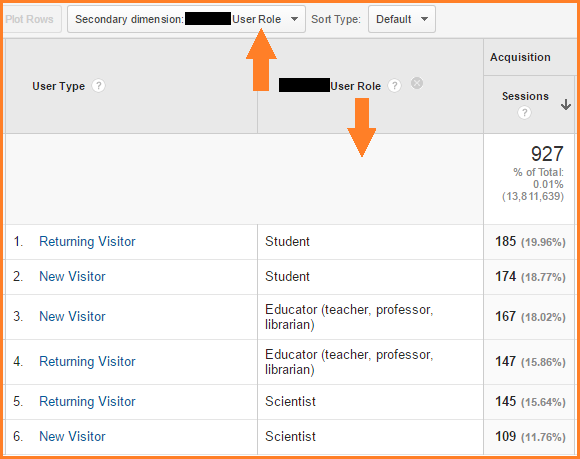Navigating the Depths of Additional Dimension in Google Analytics: A Detailed Expedition on Its Functionality
Additional dimensions, though apparently straightforward at initial glance, nurture a riches of untapped possible waiting to be taken advantage of. As we get started on this trip to discover the nuanced performance of additional measurements, we will uncover just how this feature can brighten patterns, unveil connections, and inevitably lead the way for informed decision-making in the electronic landscape (what is a “secondary dimension” in google analytics?).
Understanding Second Dimensions in Google Analytics

Comprehending exactly how secondary measurements job is important for leveraging the full power of Google Analytics. These measurements aid you respond to much more intricate questions concerning user habits and the effectiveness of your site web content and advertising efforts. For instance, you can make use of secondary dimensions to analyze which gadgets or web browsers are most frequently used by site visitors that buy, or to compare the bounce rates of various traffic resources. By combining key metrics with second dimensions, you can gain valuable understandings that drive notified decision-making and optimization techniques - what is a “secondary dimension” in google analytics?.
Leveraging Additional Measurements for Data Evaluation
Structure upon the foundational understanding of how second dimensions enhance data analysis in Google Analytics, the utilization of these added layers of details ends up being vital in removing valuable understandings for informed decision-making and optimization strategies. By leveraging additional dimensions, analysts can delve much deeper into the performance metrics by including even more context to the main dimensions, therefore discovering concealed patterns and correlations that may not be apparent initially glimpse. This much deeper degree of evaluation enables businesses to better recognize user behavior, determine patterns, and identify areas for renovation.
In addition, second measurements supply a more extensive view of the data, enabling for division based upon different criteria such as demographics, devices, web traffic sources, and a lot more. This segmentation promotes an extra granular evaluation, making it possible for services to tailor their methods and campaigns to particular audience segments for boosted targeting and personalization. In significance, the critical use of additional measurements encourages organizations to make data-driven decisions that drive growth and success in the electronic landscape.
Advanced Techniques for Additional Measurement Execution
Discovering complex methods to harness the full potential of secondary dimensions in Google Analytics boosts the depth and refinement of data analysis for strategic decision-making. One advanced method for carrying out additional measurements is the use of customized measurements. Furthermore, combining second sites dimensions with sophisticated segments can supply also more granular insights by using several layers of division to the data.
Interpreting Insights With Secondary Dimensions

When analyzing understandings through additional dimensions, it is important to take into consideration the context of the information and just how different dimensions engage with each various other. For example, understanding which specific web traffic sources result in greater conversion rates or recognizing which devices individuals like for making acquisitions can offer workable understandings for optimizing advertising projects and boosting general internet site efficiency. By meticulously analyzing the information with additional dimensions in mind, services can make informed decisions that drive meaningful results and enhance their digital existence.
Optimizing Efficiency With Secondary Measurements

One key method to optimize performance with secondary measurements is by segmenting information a lot more granularly. This permits you to isolate details elements that may be affecting your metrics and gain a better understanding of what drives success or failure in your electronic campaigns. For example, by integrating second dimensions such as 'gadget group' and 'landing page,' you can pinpoint which gadget kinds are most effective for certain landing web pages, allowing you to tailor your approaches as necessary.
In addition, utilizing additional measurements can assist you recognize patterns, patterns, and correlations that might not appear when assessing information with key dimensions alone. This deeper degree of evaluation can bring about more informed decision-making and inevitably boost the general efficiency of your web site or electronic advertising campaigns.
Conclusion
To conclude, secondary dimensions in Google Analytics play a crucial duty in improving data analysis and offering much deeper understandings right into internet site performance. By utilizing innovative methods and translating the data efficiently, services can optimize their approaches and enhance total performance. Recognizing the capability of additional measurements is vital for making informed choices and driving success in the digital landscape.
By leveraging additional measurements, experts can dig much deeper into the efficiency metrics by adding more context to the main measurements, thus revealing surprise patterns and connections that might not be obvious at very first glance. One sophisticated technique for implementing additional dimensions is the use of customized dimensions.Having grasped innovative strategies like custom measurements and regex for second dimension implementation in Google Analytics, the next vital step is interpreting the useful understandings derived via these innovative data segmentation methods. Interpreting understandings with additional measurements entails analyzing the connections in between the second and main measurements selected, revealing patterns, fads, and correlations that may not be promptly apparent when looking at the information in its totality.When translating understandings through additional dimensions, it is important to take into consideration the context of the information and just how different dimensions communicate with each other.
Comments on “Explained: The Function and Meaning of a 'Secondary Dimension' in Google Analytics”